1. Overview
Since the weather conditions directly affect the power generation of the photovoltaic power station, the core parameters of the performance evaluation of the photovoltaic power station are inseparable from the accurate meteorological data. Therefore, each photovoltaic power station monitoring system needs a set of weather monitoring sensors to calculate the power station core assessment indicators, such as station station efficiency and effective working hours. Data sampling and processing methods, sensor deployment and installation methods will also have some impact on the assessment results.
2. Sensors commonly used in photovoltaic system weather stations
The weather station requires only a small number of sensors to fully cover the assessment requirements:
Irradiator: The power station needs to use an irradiometer to measure a series of irradiances, and the irradiator's response band should cover the wavelength band that the module can absorb. Usually we use multiple irradiators at the same time to monitor the irradiation in different installations.
Horizontal installation of an irradiator for monitoring global horizontal irradiation (this installation method should avoid ground reflections as much as possible, since ground reflections may increase the measurement result by 20%);
An irradiator with the same inclination and orientation as the array is used to monitor the radiation received at the array plane;
Customized scattering irradiators for monitoring scattered radiation, ie global horizontal radiation minus direct radiation (this irradiator is not commonly used);
Reference battery pack: Contains one or more photovoltaic cells that can simultaneously measure the irradiation and cell temperature. The material of the cells in the reference battery pack should be the same as the material of the cells in the assembly used in the array; although the reference battery pack is inexpensive The price will be used as a substitute for regular irradiators, but it cannot be used in practice. The reason is that it is difficult to find reference battery packs with the same spectral response interval as the components used in the array, and their accuracy and sensitivity stability are not certified.
Component backplane temperature sensor: Mount directly on the back of the PV module to measure the temperature of the cell in the module. The measurement method utilizes a heat exchange model to convert the backplate temperature of the module to the temperature of the cell's internal cell. The conversion process also requires input of ambient temperature, wind speed, and wind direction for correction. Often, the component backplane temperature is often incorrectly referred to as the cell temperature.
Ambient temperature sensor: Used to monitor the temperature of the air around the actual operating array.
Hygrometers, barometric pressure sensors, wind speeds, wind direction sensors, and rain gauges: These factors are related to the amount of power generated, but these factors are generally not used in power plant performance assessments.
3, the importance of the correct use of meteorological sensors
The accuracy of meteorological data is the key to the performance evaluation of a power plant. The data acquisition system must integrate algorithms for detecting and rejecting outliers (invalid values) to ensure the reliability of the last stored historical data. Because outliers can contaminate existing databases, it is necessary for data acquisition systems to detect the presence of these data and process them in a timely manner. Another method is to identify the triggering event that caused the entry error value and to set the collector system to stop the acquisition when the event occurs, for example when the irradiator is in shadow the collector stops entering its data. All aspects of data collection may cause abnormal values, and sensors and communication cables are the most likely to cause data anomalies. Some strategies can significantly reduce the occurrence of outliers, most of which are related to the connection methods of sensors and photovoltaic power plant monitoring systems.
The installation of redundant sensors is a very effective way to ensure accurate measurement data. In this way, the solution that can greatly improve the quality of data collection is:
If a sensor fails, get backup data directly;
Compare and analyze the collected data from different sensors for the same time period to eliminate some abnormal values ​​that are inconsistent with the statistical trends;
Another very important parameter of weather sensors is the data acquisition cycle. The industry experience for monitoring plant operating parameters is a 15-minute average. However, for meteorological elements such as radiation intensity, which are relatively large in terms of instantaneous fluctuations, it is very unwise to sample instantaneous values ​​in 15 minute steps. So the collector needs a faster sampling frequency (possibly up to 1 s), and it outputs the average of 15 minutes of continuous data acquired at this sampling frequency. This process must carefully consider the possible outliers and timestamp synchronicity of all instruments participating in the data acquisition. Abnormal sampling or handling errors can reduce the quality of the assessment.
The meteorological conditions not only have large instantaneous fluctuations, but also the differences in local areas within large-scale power station sites are very obvious. For a power plant with a large enough area, the key performance indicators in a specific area of ​​a station must use nearby meteorological data. According to the calculation document of the relevant technical performance evaluation, it is not expected that the core meteorological monitoring data will fluctuate drastically in the entire station space, because severe fluctuations will adversely affect the calculation of the key performance of the power station on the long-term scale. Assume that some evacuated clouds are observed passing through a few megawatts of arrays. Although the effect of partial occlusions on the local transients of the array is very significant, the intensive fluctuations will be smoothed to the stability of the entire station with the duration of the day. influences. Since the object of assessment is the entire station, the input of the calculated meteorological data requires the use of the spatial average of the meteorological data of the station. This value can only be obtained by summarizing the measured data of the substations.
For photovoltaic power plants built in areas with large terrain undulations, such as PV modules installed on different slopes, full consideration must be given to the orientation of the slope, the inclination angle, and the nominal power of the components installed on each slope. Calculation of KPIs The impact to ensure the accuracy of the calculations. It is also necessary to modify the performance evaluation calculations for arrays that are installed using significant differences in technical requirements. Deploying multiple meteorological monitoring systems in different areas of the station can effectively reduce the probability of total sensor damage, such as natural disasters, theft, and physical damage.
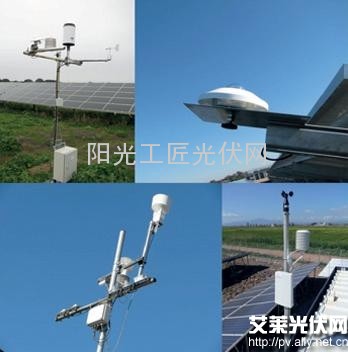
â–² Various weather sensors
Finally, high-quality meteorological sensors need to be periodically calibrated or have a limited useful life. For example, an irradiator needs to be calibrated at least once a year to two years, and a mechanical anemometer is only six months to one year old. Preventive maintenance, calibration, and replacement are essential to support the long-term operation of the power station.
4, weather station application
Photovoltaic power station meteorological monitoring system has a clear definition for the installation of meteorological sensors. The reasons are as follows:
The application of redundant meteorological sensors;
When calculating azimuth-sensitive key performance, sensor measurement data using a specified installation method is required;
The concept of a weather station is the best interpretation of the relationship between a weather sensor and its installation location. The weather station integrates a set of meteorological sensors and their spare parts, supports, power supply equipment, and a local number collector for processing and storing the measured data. These sensors are installed in a designated manner and the plant monitoring system can read these coordinates and configurations. Weather stations are not a new concept and all meteorological services around the world use them as a basis for meteorological monitoring systems. The meteorological station is easy to install and has a low installation cost, so it is reasonable to purchase a slightly more expensive integrated system than buying each meteorological sensor.
Since the definition of the weather station concept has been defined, it is a very practical implementation strategy to configure the standardization of the weather station and perform weather station quotas on the characteristics of the station. In addition, in practice, the rated output power, the physical area, and the number of ramps are generally used to define the typical characteristics of the local area within the power station. The two complement each other not only can synchronize the cable and power supply design, but also simplifies the design of the monitoring system, the construction of the station and the implementation of the instrument calibration of the entire life cycle of the power station.
5, radiation measurement case
In order to calculate the most important power plant performance, we need to obtain accurate and reliable main meteorological data, so the evaluation of various types of radiation measurement instruments is a crucial step. At present, there are two types of mainstream radiation measurement instruments for use in photovoltaics, irradiators and reference batteries.
Based on the actual irradiance data collected from various types of instruments by the radiation monitoring system, the results after the comparative study showed significant differences among the various instruments. The experimental data was taken from a 1.7 MW photovoltaic power station, in which various types of meteorological sensors were installed. The details are as follows:
2 WMO secondary standard irradiators;
7 WMO second-class standard irradiators;
2 reference battery packs;
The selected observation period is two weeks in which there is no fault or major problem occurring in October that is suitable for the instrument comparison experiment. Before the start of this experiment, the photovoltaic power plant has been put into operation for more than a year.
The acquisition frequency of the irradiation data was 1 second, and the recorded data was averaged in 15 minute steps. All irradiance analog signal current ranges used for sampling are 4-20mA for the following reasons:
Better fault detection
Better anti-noise performance
In order to eliminate the influence of shadows in the morning and evening, data with an irradiation value less than 200W瀖-2 were filtered out. Similarly, data with an exposure value lower than 200 W瀖-2 will not be used when calculating system efficiency.
The data of the secondary standard irradiator is used as the reference data. The technical requirements for the secondary standard irradiators are the highest specifications and they need to be independently calibrated according to the relevant requirements. The relevant requirements also specify the cumulative uncertainty level of cumulative hourly and daily accumulations. In order to ensure that the two standard irradiators deployed in different regions meet the requirements of the specification, their timing uncertainty test results need to be within the specified values. The details are as follows:
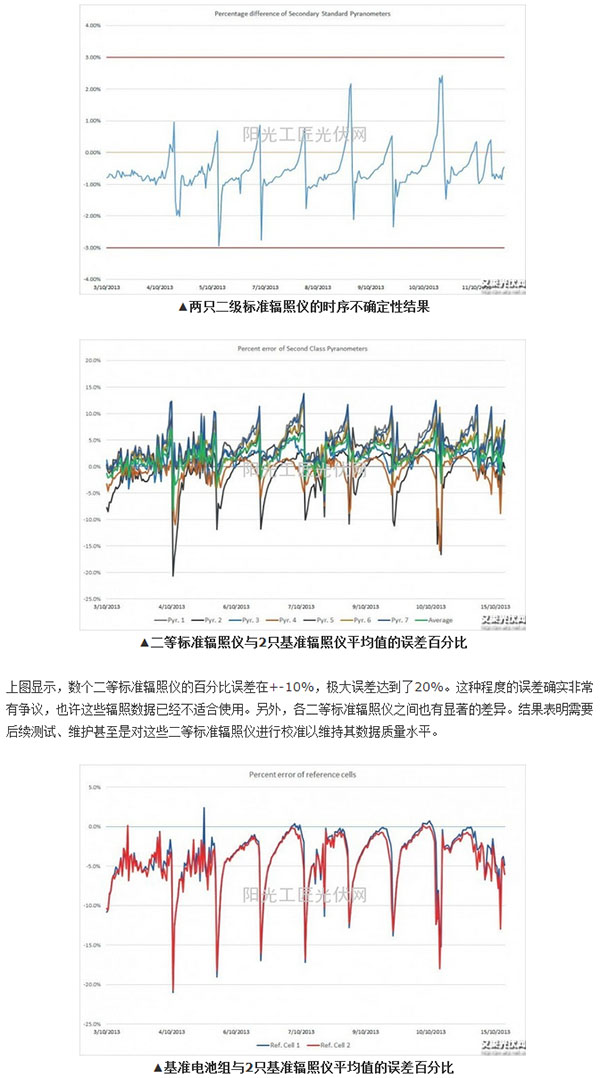
The above figure shows that the measured value of the reference battery pack not only maintains a negative percentage error, but also fluctuates greatly in the morning.
When using irradiance data to calculate system efficiency, the importance of using accurate irradiance data is obvious. The result of comparing the efficiency of the different radiation data calculation systems is shown in the figure below:
a) Average of secondary standard irradiators
b) Average of second-class standard irradiators
c) Average of the reference battery pack

6. Summary
The meteorological sensors play an important role in the monitoring system of photovoltaic power plants. Accurate meteorological observation data is the key to tracking, evaluating and controlling the performance parameters of photovoltaic power plants. Therefore, the correct installation of a sufficient number of meteorological sensors and related equipment, and the proper collection of appropriate data related to the photovoltaic power plant, can ensure that unavoidable errors do not lead to erroneous assumptions and results. Only the rational use of redundant sensors, sampling frequency, data cleaning and calibration, and correction according to the characteristics of the power station can obtain the best performance analysis results.
It is well known that secondary standard irradiators are expensive, and not all power stations have the conditions for implementation in the text. How can we solve these problems in the implementation phase of the project? After the translator summarizes the main ideas of the full text, he believes that if the cost of using high-precision instruments is too expensive, then the next step requires the comparison of nearby measured data. Layer data analysis, near the high standard station machine learning curve, satellite and pattern data trend judgment and other methods. In the era of big data, it is the general trend to fully tap the value of core data and improve social efficiency.
As knows, experimental use of high-visibility clothing began in 1964 on the Scottish Region of British Railways, and now, the Hi-vis Safety Vest is a basic necessity of personal protective equipment. It is widely used in railway and highway, airport, construction site, or riding, exercising.
The main components of these vests are fabric (highly visible) and reflective strip, usually yellow, orange, red or black. Depending on demand, it can also be flame retardant, antistatic, Basic Style Safety Vest, Multi Pocket Safety Vest, Children Safety Vest and Sports Safety Vest etc.
Where some may think that a vest is just another disposable
item of PPE, we see it as a lifesaver ! We care about wearer safety and wearer
satisfaction. We don't just sell garments from stock, you can also customize. All of our vests can be print
or embroidered any logo and are quality products at very competitive
prices.
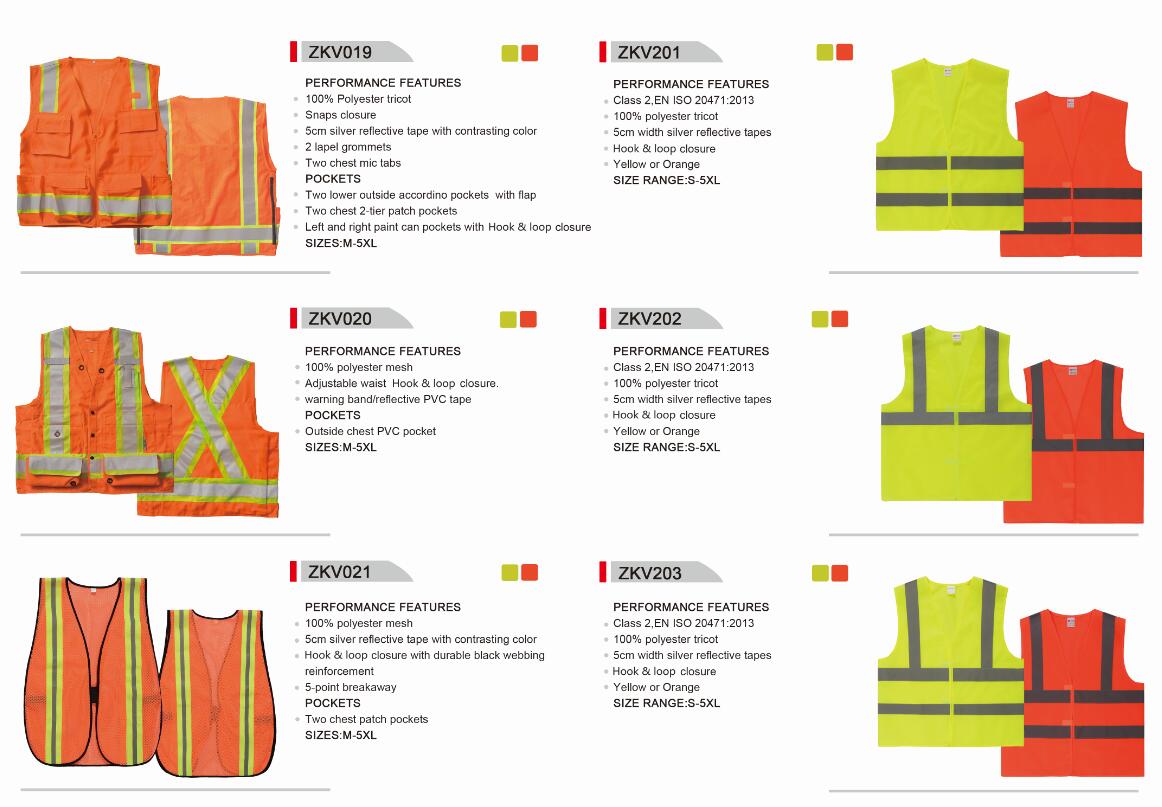
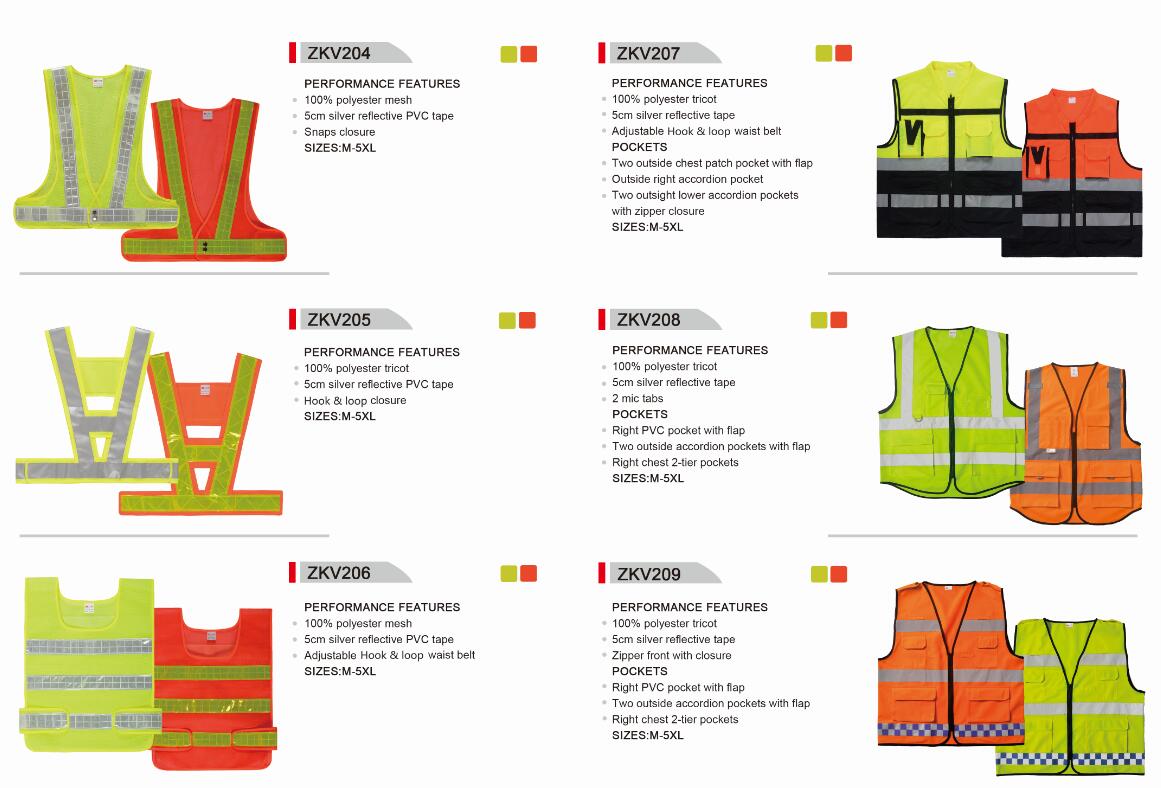
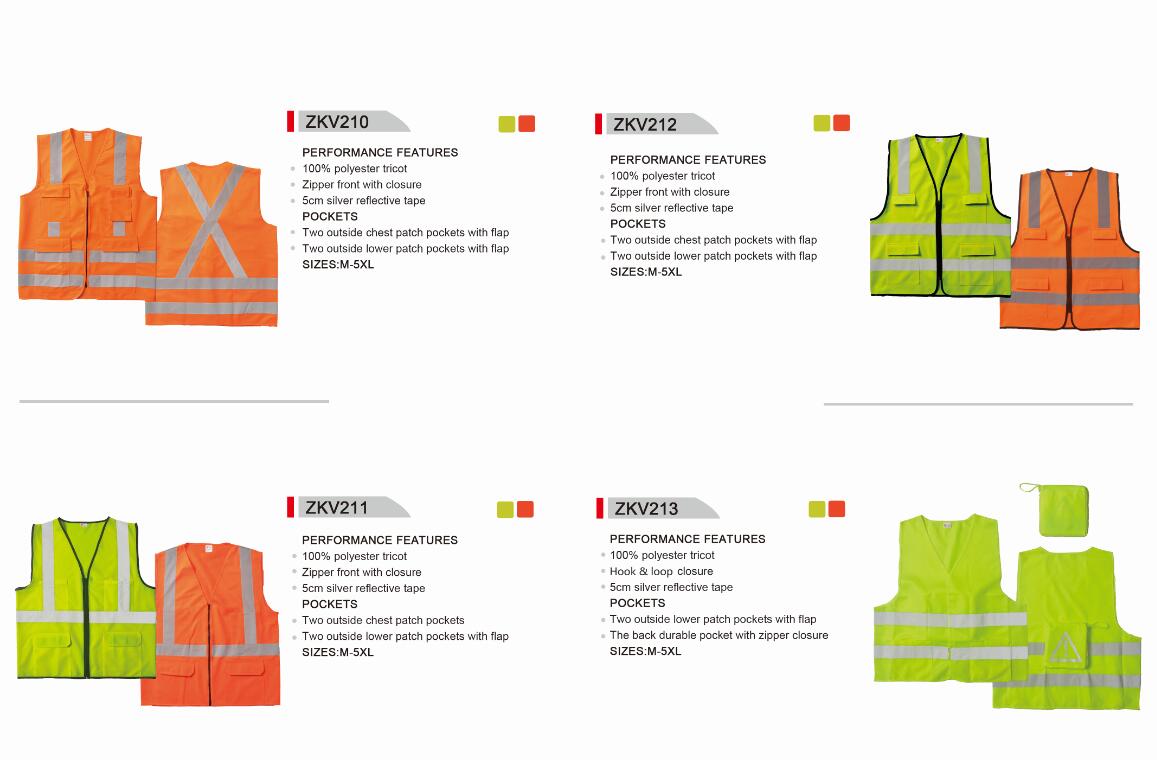
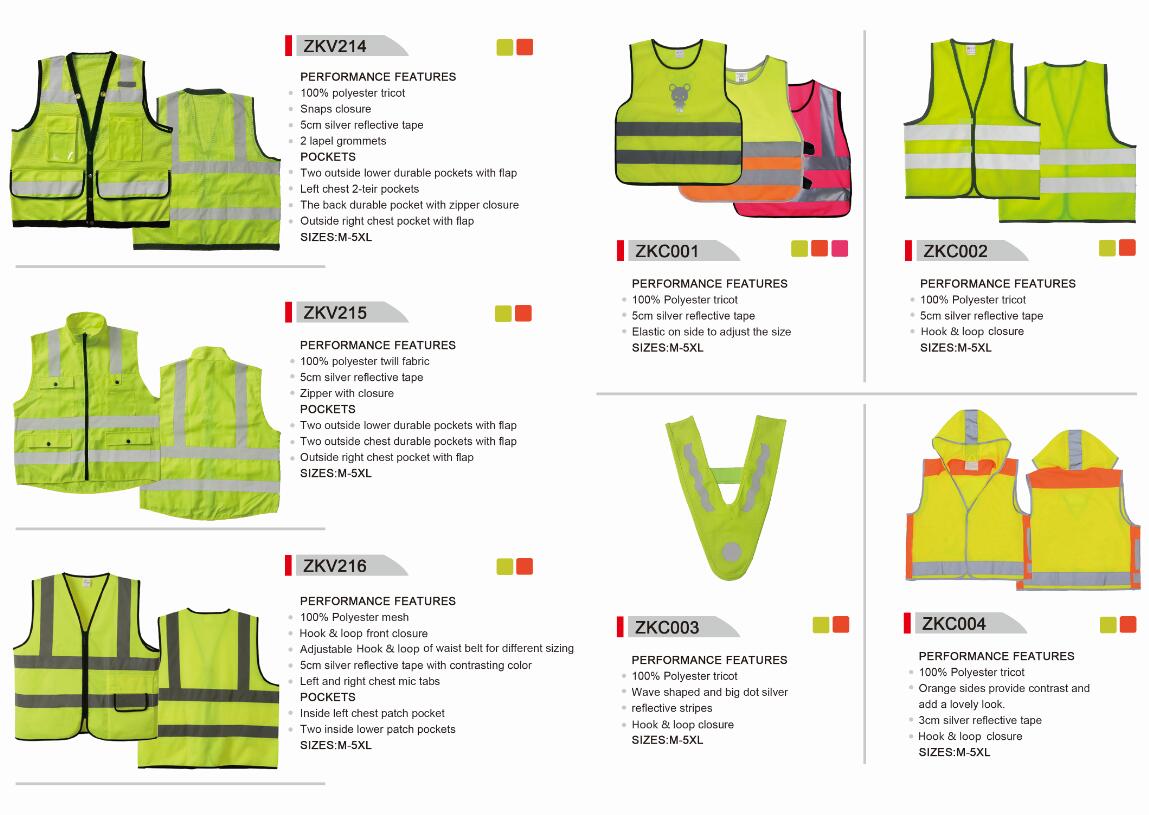
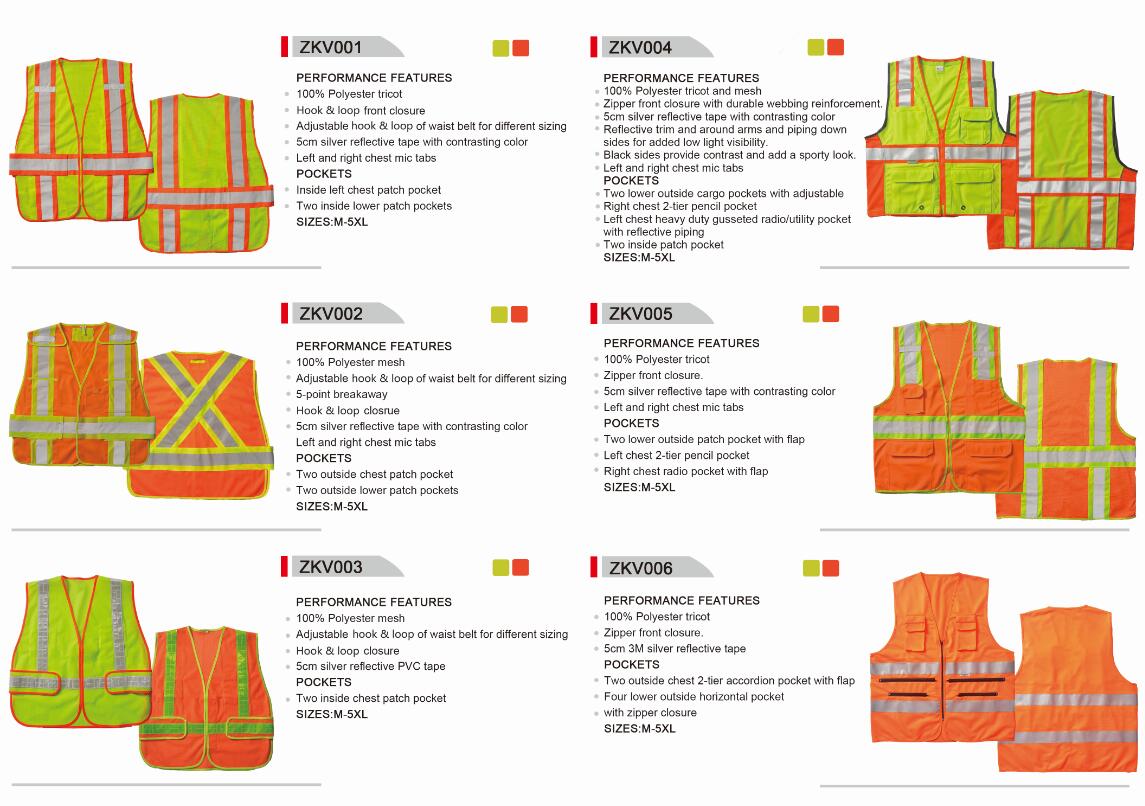

Hi-Vis Safety Vest,High Visibility Clothing,High Visiblity Safety Vest,High Visibility Vest
Xinxiang Zhongke Reflective Material Co., Ltd. , https://www.zkprotective.com
